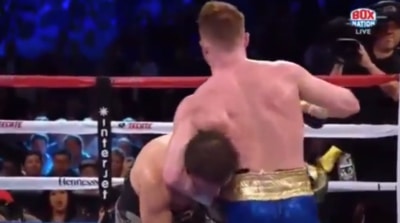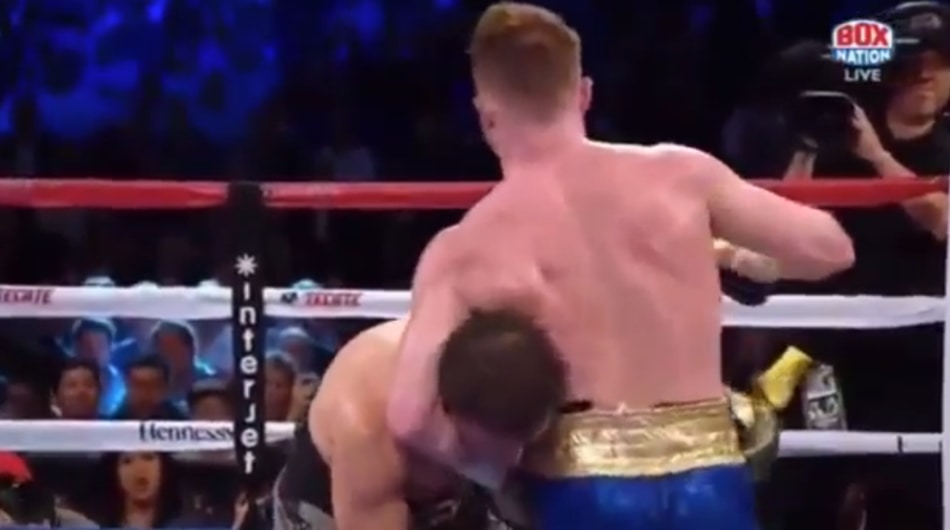

Common sense would suggest that headlocks are not allowed in boxing. However, you often see them—or something that resembles them—in professional fights. Why is that?
By the book, a fighter cannot use a headlock in boxing. The maneuver falls under the umbrella of wrestling, which is prohibited in the sport. As noted by BoxRec, you cannot hold or wrestle your opponent. But much like with pushing, professional fighters are granted some leeway when it comes to holding and clinching.
So what is permitted and what is not? Are there any examples of fighters using headlocks to their advantage?
Legality of Headlocks in Boxing
First and foremost, we should explain what a headlock is. Generally speaking, the move is performed by wrapping your arms around your opponent’s neck while facing them. From there, you can lock your hands together (hence the name) and apply pressure in order to choke out your opponent.
Obviously, the latter part of that description is not legal in a boxing ring because it constitutes wrestling.
Boxers can get away with a loose version of a headlock, though. If your opponent ducks into your body, you can briefly place your arm around their neck as a form of defensive clinching.
With that said, there are also some guidelines to keep in mind. The first is not to lock your hands. A loose headlock should only involve one arm, and it is not a submission attempt but rather a means of stalling, tiring or irritating your opponent.
Secondly, you can only put your arm around their neck for so long before the referee separates you. Some officials will offer fighters a bit more rope and encourage them to break it up organically, whereas others will step in almost immediately. Fighters must take a step back after being separated. In the interest of a fair fight, hitting on the break is not permitted.
If the referee frequently intervenes and a fighter continues to initiate this type of clinch, they will receive a warning and perhaps even a point deduction.
Amateur boxing is stricter than professional boxing and does not tolerate loose headlocks.
Benefits of headlocks in boxing
Technically, headlocks are not legal in the squared circle. But as we have discussed, you can use some semblance of a headlock in professional fights.
There are a few reasons why you might want to:
- By immobilizing your opponent’s head, you are effectively stifling their offense. Fighters cannot throw proper punches if they have someone’s arm wrapped around their neck. As a result, you are relatively safe.
- If you lean on your opponent from this position, you can force them to carry your weight. This can grow very tiring for them—especially if you do this whenever they attempt to get close.
- This can also disrupt their rhythm. Over time, that can lead to frustration and thus mistakes that you can capitalize on later in the fight.
- If you find yourself cornered by your opponent, you can work out of this position by wrapping your arm around their neck and walking to a safer area. By the time the referee breaks up the clinch, you should be in a better situation than you started in.
- This holding technique is a great way to simply get a breather. When you need to recover from fatigue or taking a clean shot, initiate a clinch and remain there for as long as the referee lets you. Those few seconds of rest can mean the difference between staying in the fight and getting finished.
As you can see, a loose headlock is very much a defensive tool. We touched on the importance of defensive clinching in a previous ShortBoxing article:
“Boxers would love to be able to stay on the offensive throughout a match. But having a thorough defensive strategy is the key to victory for many boxers. It’s a strategic maneuver that needs to be a part of your skillset if you want to be a competitive boxer.”
There are not many offensive applications of the headlock in boxing because wrestling is not allowed. Also, you are forced to take a step back after the break, negating any sort of immediate advantage you might have held by initiating the clinch.
Nevertheless, there is a time and place for a headlock in the professional side of the sport.
Examples of headlocks in boxing
Despite being illegal, loose headlocks are very prominent in professional boxing. Many fighters use this tactic to slow their opponent down or gain a few seconds to recover.
Wladimir Klitschko vs Alexander Povetkin
One of the most notorious examples occurred in the 2013 heavyweight title bout between Wladimir Klitschko and Alexander Povetkin. Though Klitschko had always been clever about his use of clinching, he went overboard with it in this fight. Povetkin was the smaller combatant and therefore needed to close the distance.
Every time he attempted to do so, Klitschko would either wrap his arm around Povetkin’s neck or clinch with overhooks until the referee stepped in.
It was such an ugly contest that the fans in attendance booed throughout. In the end, Klitschko landed 139 punches to Povetkin’s 59. He initiated over 180 clinch exchanges. This shows that using a headlock might not be the prettiest strategy, but it can be quite effective depending on the officiating.
Andre Ward vs Mikkel Kessler
Another glaring instance was the 2009 super middleweight fight between Andre Ward and Mikkel Kessler. Ward eliminated Kessler’s threats by choosing to clinch almost 90 times, alternating between bumping in, headlocks and bear hugs.
In fact, Ward relied so heavily on clinch work that he accidentally headbutted Kessler in the 10th round. This opened up a cut and forced the referee to stop the fight one round later. Ward won by technical decision.
With that said, heavyweights appear to be the guiltiest culprits when it comes to headlocks, and the reasoning behind that is simple: Since these fighters are bigger and heavier, their punches are more dangerous. As such, you need to be more cautious defensively.
One shot can put your lights out. Furthermore, forcing your opponent to carry your weight is particularly beneficial when you weigh a lot. It drains their gas tank and makes them more vulnerable to your attacks in the later rounds.
Lennox Lewis
Retired heavyweight legend Lennox Lewis was a master of using headlocks in the ring. He would apply pressure, and before his opponent could return fire, he would smother them with clinch work. This not only neutralized their offense but also sapped their energy. While many criticized Lewis’ style, it helped him win fights. What else really matters?
Tyson Fury vs Deontay Wilder
Of course, there are more recent examples as well.
In the high-profile heavyweight rematch between Tyson Fury and Deontay Wilder in 2020, we saw the value in holding your opponent. Wilder’s overhand right may represent the single most devastating punch in boxing, but he requires space to throw it.
Fury’s adjustment from the first fight was to crowd Wilder and lean on him when they got up close. After he knocked Wilder down in the second round, he dialed up the pressure and stayed in his face for the remainder of the fight, peppering him with volume and clinching whenever Wilder ducked under punches.
Considering Fury is the larger man and came in even heavier for the second fight, this strategy yielded major dividends. Thanks to damage and fatigue, Wilder could barely stand as the bout progressed. His corner threw in the towel halfway through the seventh round.
Anthony Joshua vs Joseph Parker
Meanwhile, the 2018 heavyweight contest between Anthony Joshua and Joseph Parker featured a fighter trying to use headlocks to set up their offense. Facing a speedier opponent, Joshua imposed his will on the fight through sheer physicality. Any time he got close to Parker, he wrapped him up and then took a half-step back to create an angle for his rear uppercut.
You could consider that hitting on the break, and the referee was extremely strict about in-fighting. He did not deduct points, but he repeatedly separated the fighters before any clinch work could materialize. Joshua still prevailed by unanimous decision.
Headlocks may not be legal according to the rules, but they definitely show up to a certain extent in professional boxing fights.
Headlocks in Other Combat Sports
If you are an MMA fan, you know that headlocks are quite different in that sport. They are a general term that encompasses a wide variety of holds from different positions. The most important distinction from the world of boxing is that headlocks can be offensive maneuvers intended to make your opponent tap out.
Guillotines are a favorite among MMA fighters. They are similar to a headlock in boxing, but the fighter’s hands are obviously locked. Most of the time, this move is performed on the ground with the fighter in full guard (on their back with their legs wrapped around their opponent). This holds the opponent in place and allows the fighter to apply more pressure around the neck.
UFC lightweight champion Charles Oliveira, featherweight contender Brian Ortega and former bantamweight champion Urijah Faber are all known for their guillotines. Jon Jones famously defeated Lyoto Machida by standing guillotine in 2011 as well.
Another common headlock is the rear-naked choke. This is performed by taking your opponent’s back with a body lock, flattening them out to prevent an escape and then applying a headlock from behind. The RNC has become perhaps the most popular submission hold in MMA over the past decade.
Multi-division legend BJ Penn and welterweight grappler Demian Maia both obtained several marquee wins with this technique.
Then there is also the bulldog choke and neck crank. A recent example of the former took place in Ben Askren’s 2019 win over Robbie Lawler, whereas the latter was immortalized in 2018 when Khabib Nurmagomedov used it to submit Conor McGregor in the biggest UFC fight of all time.
Conclusion
Headlocks are technically not allowed in boxing, but professional fighters can use a loose one-armed headlock in a defensive manner. This slows your opponent down, neutralizes their offense and allows you to regain some energy or a better position in the ring.
Keep in mind, however, that the legality of this move depends entirely on the referee’s tolerance for clinch work. They may let fighters sort it out themselves. Alternatively, they may step in right away to separate the fighters. If you keep holding your opponent, you may receive a warning or even lose a point.
As such, headlocks should not form an integral part of your game plan. They are merely a nice defensive tool to get you out of trouble at times.
